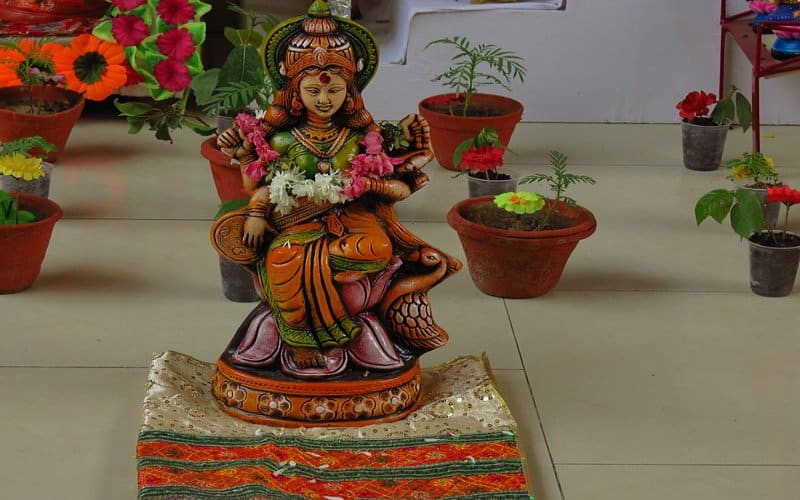In Hinduism, knowledge is considered divine. It’s not related to the senses but spirit. That is why knowledge in Hindu Dharma always has a spiritual dimension and it is never knowledge for the sake of acquiring knowledge.
The great pantheon of Hindu Goddesses assist their devotees in their material and spiritual journeys helping them ride through the sansar(world) of maya(illusion) and attain moksha, that is salvation. Each Goddess fulfills a specific function in the journey of its devotees. Devi Saraswati or Goddess Saraswati is considered the Hindu Goddess of knowledge, learning, wisdom, and creativity.
Devi Saraswati is associated with the acquiring and propagation of all kinds of learning and knowledge including academics, music, arts, sciences,crafts, and spiritual learning. She is considered a part of the trinity of Parvati, Lakshmi, and Saraswati. Devi Saraswati embodies the essence of knowledge and human consciousness. She is also known as the Goddess of Vak or Speech. Therefore, one of her many names is also Vak Devi(Goddess of Speech).
She is also known by other names such as Brahmani (power of Brahma), Brahmi (goddess of sciences), and Bharadi (goddess of history). Devi Saraswati is also known as the mother of the Vedas(sacred Hindu texts).
Symbolism of Devi Saraswati
The name Saraswati is a combination of two words – “saras” meaning flow and “vati” meaning she who has. That is why Devi Saraswati embodies the flow of consciousness. Knowledge is never static, it always flows like a river, assimilates new influences, and reinvents itself in the process. Similarly, Goddess Saraswati is like a river of consciousness in eternal flow.

Another literal meaning of Saraswati is “Sara” meaning essence and “swa” meaning self. Devi Saraswati also embodies the essence of the self. The essence of the self lies in knowledge. However, this knowledge is not cold or disconnected from emotions. It is also not the kind of egotistic knowledge that is disconnected from spirituality. The knowledge that Goddess Saraswati embodies is balanced and sublime, it dispels the darkness of ignorance and makes the seekers of that knowledge more humble, humane, and sensitive.
Devi Saraswati has remained an important Goddess from the Vedic period to the modern period of Hindu religion and traditions. Originally, she was referred to as the Saraswati River in the Rigveda. According to the Rigveda, she is the best of mothers, rivers, and Goddesses.
She is celebrated as a feminine deity of the healing and purifying powers of abundant, flowing water. She is also sometimes associated with rhetoric, eloquence, creative work, and anything whose flow purifies the essence of self.
Devi Saraswati Origins
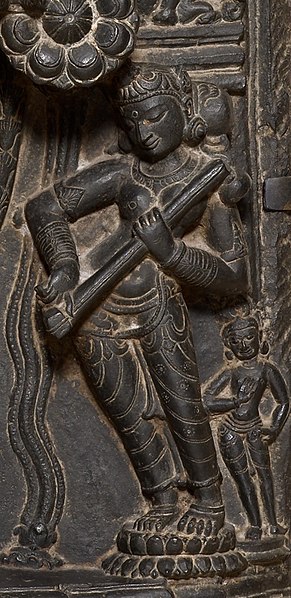
In Hinduism, lord brahma is considered the God of creation. According to ancient Hindu scriptures, Brahma found something to be missing when he created the universe.
He realized that the universe was unformed and chaotic, that it lacked structure, order, organization, and concept. That is when lord Brahma created Goddess Saraswati from his mouth to help him with the task of giving form and structure to the universe.
Brahma told her that her name is Saraswati and ordained that she should stay on the tip of everybody’s tongue. She should dance, especially on the tongues of learned people. He asked her to live on earth in the form of a river and, as a third form, to live in him too.
Sarawati agreed to this. So she is Brahma’s active energy and power in one of her forms.
Thus, Devi Saraswati emerged from Brahma and started giving him directions on creating order in the universe- the sun, the moon, and the stars came into being. As Devi Saraswati started giving order to the chaotic universe, lord Brahma discovered the melody of mantras and the sound of these divine mantras filled the cosmos with prana or vital energy.
In this way, with the creation of Goddess Saraswati, the order of this universe was established. Gods ruled the celestial regions, demons ruled the nether worlds, and humans walked on the earth. The sun, the moon, and stars rose at their fixed timings. The cycle of season change was established, plants began to bloom, animals started to migrate and thus the rhythms and patterns of human life were established.
Devi Saraswati transforms into a river
The story behind Goddess Saraswati becoming a river is mentioned in the Padma Purana and the Skanda Purana.
According to the ancient Hindu scriptures, a fierce battle once broke out between Bhargawas(a Brahmin group) and Heyas( a kshatriya group). A fire called Vadavagni was born from this raging battle. This fire was so strong it could end up destroying the whole world.
That’s when Gods approached Lord Shiva to do something and save the world. Shiva advised the Gods to go to Devi Saraswati and request her to take the form of a river and carry the Vadavagini into the ocean. Devi Saraswati agreed to do this on the condition that lord Brahma would ask her to take the form o a river. Thus, the Gods requested Lord Brahma to tell Devi saraswati to become a river. Lord Brahma asked her and thus she assumed the form of a river and carried the raging fire to the ocean.
According to another version of the same story, lord Shiva once saw that the world was getting consumed by evil. He thus opened his third eye to purify the world. Devi Saraswati thus manifested herself as a river and absorbed the raging fire of evil. She carried it into the ocean where the fire took the form of a creature called Vadavagni
Goddess Saraswati Legends
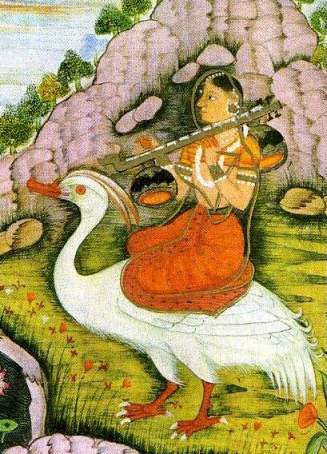
There are many legendary stories surrounding the Goddess. According to one legend, originally Lakshmi, Saraswati and Ganga were the wives of Shri Hari. Saraswati felt that Shri Hari was getting fonder of Ganga. She complained to Lakshmi, but Lakshmi was neutral. Saraswati was irritated and cursed Lakshmi to become a tree because she was insensitive.
Ganga felt bad and cursed Saraswati. This led Saraswati to curse Ganga. Reacting to this situation, Shri Hari gave dispensations, and accordingly, Lakshmi was to be born as a tree in the house of a king. Sarawati was declared to exist as one part of a river, one part of which would remain with him, and another of which would later become Brahma’s wife.
According to another legend, Brahma, the creator, fell in love with the woman who appeared from his own mind. Noticing his amorous glances, she turned to the right side of the deity. The deity produced a new face toward his right.
When she appeared on his other two sides, two new faces emerged in these directions. As a last resort, she leapt into the sky. A fifth face emerged from the deity, looking upwards. Conceding her defeat, she consented to become the deity’s consort.
Saraswati in the Ramayana
According to the Hindu epic Ramayana, Ravanna, along with his brothers Vibhishana and Kumbhakarna, performed penance to appease Brahma. Brahma offered each a boon. But other Gods pleaded with him not to grant Kumbhkarna his boon.
Then Brahma summoned his consort, Sarawati, and told her to say whatever the gods desired. When Kumbhakaran spoke to invoke his boon, she entered his mouth, causing him to say, “To sleep for innumerable years.” She then exited his body. However, his brother Ravana requested lord Brahma to withdraw the boon as it was indeed a curse. Brahma couldn’t withdraw the boon entirely but he changed it to make Kumbhkaran sleep continuously for six months in a year and then wake up for a day to eat to his heart’s content and then go to sleep for another six months.
Goddess Saraswati Representation
Goddess Saraswati is often depicted as a beautiful woman dressed in pure white, often seated on a white lotus, which symbolizes light, knowledge, and truth. Her countenance is calm and soothing. She not only embodies knowledge but also the experience of the highest reality.
In the scriptures, she is generally described as being as white as the moon, adorned in white ornaments, and holding a book and a pen in her hands.
She is often shown with four arms, but sometimes just two. She is holding in her four arms a book, a rosary, and the Indian musical instrument veena.
The book symbolizes the Vedas, which represent universal, divine, and eternal knowledge as well as all forms of learning. The rosary represents the power of meditation, inner reflection, and spirituality. Lastly, her musical instrument, the Veena, symbolizes the essence of fine arts and crafts. The musical instrument that Devi Saraswati is holding becomes a manifestation of supreme creative and artistic expression.
A Hansa (swan) is often shown near her feet. In Hindu mythology, the Hansa is a sacred bird, which if offered a mixture of milk and water, is said to be able to drink only milk. It symbolizes the ability to discriminate between good and evil, appropriate and inappropriate. This discerning ability of the intellect stands for Viveka ( wisdom ) in Hinduism.
Sometimes, a peacock is shown beside her. The peacock symbolizes colorful magnificence and the attractions of the material world. It’s actually representative of avidya or ignorance, the overpowering influence of the senses that one needs to overcome through the single-handed pursuit of vidya or knowledge. She is usually depicted near a flowing river, which is a reference to her early history as a river Goddess. As a river Goddess, she represented fertility and purity.
Saraswati and Brahma
Devi Saraswati was created by lord Brahma from his mouth to give order and coherence to the universe. Many Hindu scriptures also mention Devi Saraswati as the consort of lord Brahma.This has led to a lot of controversy and misrepresentation wherein it’s commonly assumed that lord Brahma married his own daughter, that is Devi Saraswati.
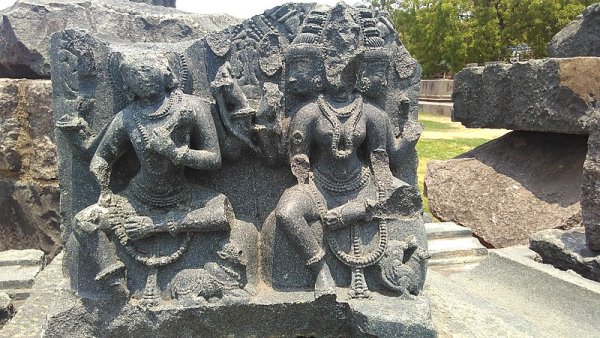
One has to understand that Devi Saraswati wasn’t Lord Brahma’s daughter in the conventional sense of the term. She was created by him to assist him in the task of managing the universe. Her creation served a purpose and that is why lord Brahma created her. So this cannot be fitted into the simplistic paradigm of father and daughter.
Brahma represents the abstract, while Goddess Saraswati represents action and reality. She is considered to be the embodiment of his power, the instrument of creation and energy that derives from his actions.
The Curse of Saraswati
According to scriptures, lord Brahma got so enamored by the celestial beauty and intelligence of Saraswati that he lusted after and directed his gaze at her, no matter wherever she went.
Devi Saraswati strongly disliked his lust so she tried her best to escape his gaze but no matter which direction she moved in, Brahma grew another head just to be able to catch a glimpse of her. This is how Brahma came to have 5 heads, he grew a head in each direction to be able to look at Goddess Saraswati.
Devi Saraswati got so angry at his display of unbridled passion that she cursed him saying that he was not worthy of reverence and that there may be no temples or festivals in his name. Till this date, it is believed the curse of Saraswati holds true as there are very few temples in India where Brahma is worshipped.
Shiva confronted Brahma as Bhairava
But the curse didn’t seem to have any effect on lord Brahma as he continued to display his desire for Goddess Saraswati.
Brahma’s actions motivated by the extremity of desire disturbed the peace and serenity of the universe. This angered lord Shiva who came out of his meditative state, opened his eyes and turned into Bhairava, lord of terror. He cut off Brahma’s fifth head, an action that got Brahma out of his lustful reverie.
The cut head of lord Brahma clung to Bhairava’s hand sapping all his strength. Thankful for his timely intervention, Saraswati came to Bhairava’s rescue as she nursed him like a benevolent mother, thus restoring his sanity.
Brahma sought to conduct a yagna or a fire sacrifice ritual to get rid of his lustful ego and start afresh. However, as per protocol he needed a wife to conduct the ritual along with him. He thus chose Devi Saraswati to be his wife and this is how she became his consort.
Manifestations
There are many forms and manifestations of Devi Saraswati. She is venerated in some regions as MahaSaraswati. MahaSaraswati is depicted as eight-armed. She is said to be born from the body of Gauri (Parvati) and to be the sustaining base of the three worlds.
She is also considered one of the nine forms of Shakti, who is revered in India as a powerful and dangerous goddess.
One of her other forms is Mahavidya Nila Saraswati. However, she is not much different from the traditional Saraswati. Though Saraswati is the calm, compassionate, and peaceful one, Nila Saraswati is its angry and destructive manifestation. In some parts of India, she is revered as an incarnation of the goddess Tara.
As Sharada, she is worshiped in Kashmir. Here she is a tripartite embodiment of Goddesses: Sharada, Saraswati, and Vagdevi. According to people’s beliefs, the abode of the Goddess should not be looked at directly. The shrine contains a slab concealing the spring underneath, which they believe to be the spring in which goddess Sharada revealed herself to a sage.
Devotion
Devi Saraswati is invoked to remind the worshiper to meditate on virtue, virtuous conduct, and the meaning and very essence of one’s activity and actions.
She is worshiped during the final three days of the Navratri festival. The celebrations start with the puja. It consists of placing the books for puja. It may be in one’s own house, at a local school, or in a temple for instance.
Following worship, the books are taken out for reading. The child is often ritually taught to write for the first time on rice spread on a plate. Cultural programs are also organized on this day.
On Saraswati Day, people in Bali, Indonesia, make flower offerings in temples and sacred texts. On this day, they go to the sea or sacred waterfalls to offer prayers and then rinse themselves in that water. It is often celebrated with theater and dance performances.
One of the most popular festivals associated with Goddess Saraswati is the Hindu festival of Vasant Panchami. It is celebrated on the fifth day of the Hindu calendar month of Magha. This day is also known as Saraswati Puja and Saraswati Jayanti.
It is said that chanting the Saraswati mantra 64 times every morning and evening for 21 consecutive days will help devotees get the blessings of the Goddess.
Since Devi Saraswati is the Goddess of all knowledge and wisdom, in India, it is customary to have “Saraswati Vandana”( a song dedicated to Goddess Saraswati) before the beginning of any educational or cultural event and programme.
Symbols of Goddess Saraswati
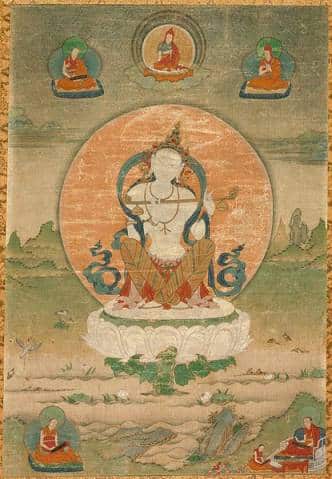
Colors
White: Goddess Saraswati’s iconography is typically in white themes, from dresses to flowers to swans. The white color symbolizes Sattwa, i.e., purity and discrimination for true knowledge, insight, and wisdom.
Yellow: Saraswati’s favorite color is yellow. People often offer her flowers like sunflowers, marigolds, and allamanda during her puja.
Plants
Lotus: The Goddess is often depicted as sitting on a white lotus, which symbolizes light, knowledge, and truth. The lotus flower in Hinduism is viewed as a symbol of purity, strength, resilience, and rebirth.
Peepal (Plaksa Prasravana): Peepal is often identified with her. Within the Shivalik Mountains, it is the source of the Saraswati River.
Animals
Swan: The Swan is considered Saraswati’s vehicle. It is shared by her with Lord Brahma. The swan symbolizes the ability to tell the difference between what is good and bad, right and wrong. It also represents the soul’s yearning to reach the highest peaks as well as go beyond them.
Peacock: The peacock is the devourer of snakes, and in this sense, it symbolizes the ability to transmute the serpent poison of the self into enlightenment. Peacocks also change with the weather, symbolizing the fickleness of the human mind. It also symbolizes arrogance and pride.
Instruments
Veena: Saraswati is the Goddess of the arts. Veena represents this artistic aspect of her. Also, it serves as a reminder to tune one’s heart and mind to live in harmony with others and the world.
Perfumes/Scents
The scents associated with the Goddess are marked by Eastern floral notes of gardenia and tuberose. These are accented with the purifying scents of myrrh and rich sandalwood.
Gems and Metals
Emerald is associated with Goddess Saraswati. The emerald stone is considered the stone of wisdom and intellect. Wearing it in combination with other stones is believed to enhance success in exams, business, and concentration while studying.
FAQs about Saraswati
Many mantras in the Rigveda praise Goddess Saraswati in her divine form. In this Veda, she is regarded as the mother of all.
The color white is associated with Devi Saraswati, as it symbolizes purity and true knowledge.
Khichdi, pulao, and sweet dishes made with jaggery are often offered to Devi Saraswati during worship.
Thursday is dedicated to Goddess Saraswati. Worshipers hold fast on this day to honor her.
Other Goddesses
If you enjoyed this post we are sure you will enjoy getting to know some of the other goddesses we also write about. You can find the complete list of goddesses sorted across regions and religions here.
Featured Image Credit: Siva301in, CC BY-SA 3.0, via Wikimedia Commons

